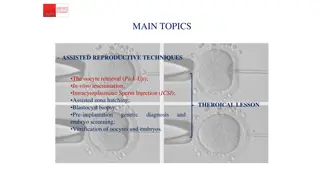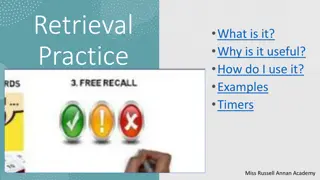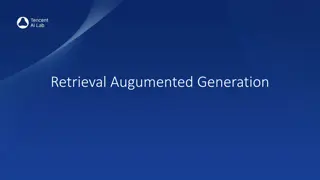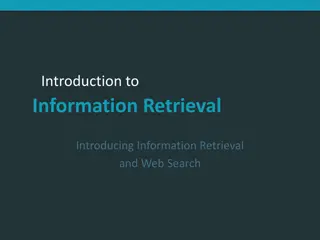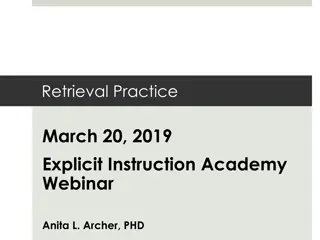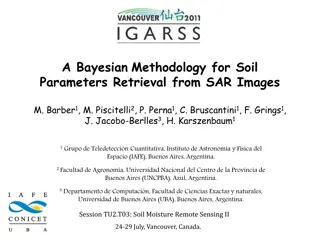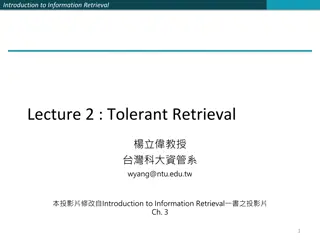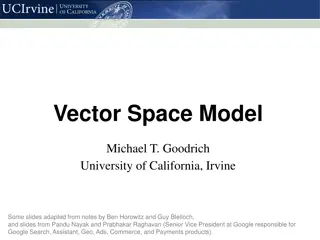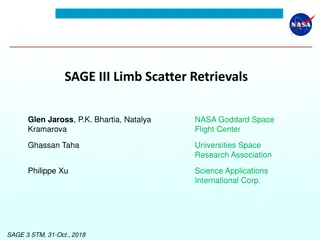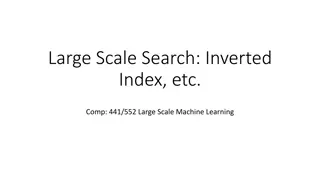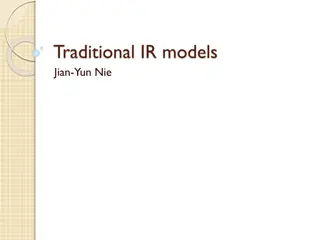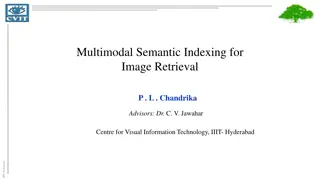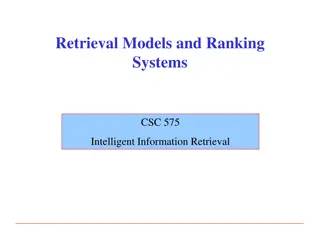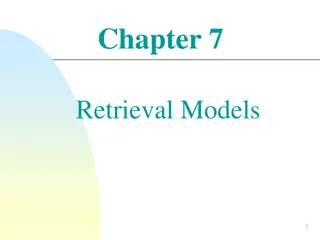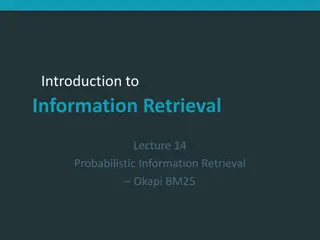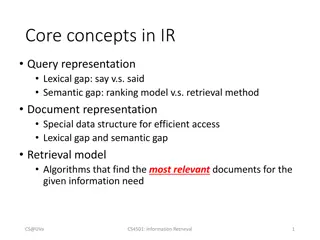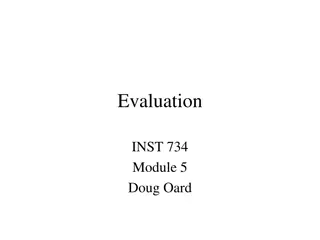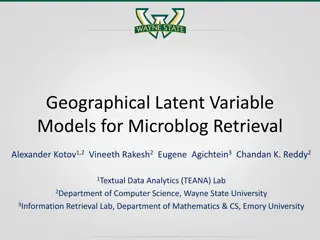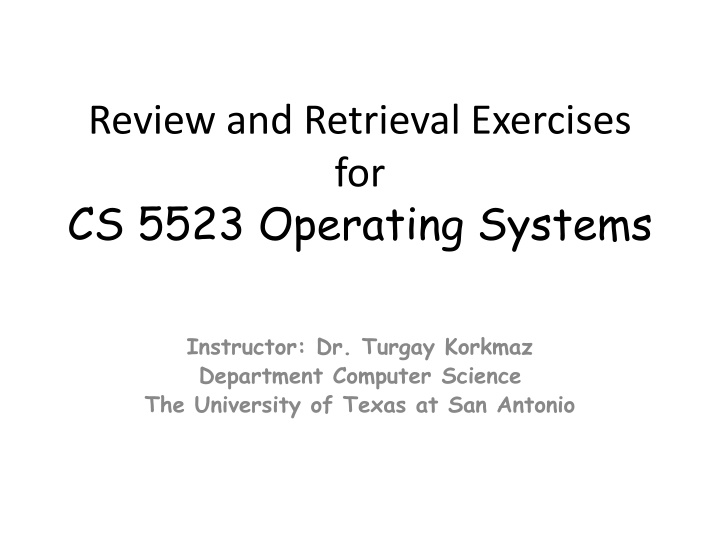
Operating System Review and Retrieval Exercises for CS 5523
Enhance your understanding of operating systems with these comprehensive review and retrieval exercises for CS 5523. Explore key concepts such as OS introduction, processes, threads, and more in depth, guided exercises designed by Dr. Turgay Korkmaz.
Download Presentation

Please find below an Image/Link to download the presentation.
The content on the website is provided AS IS for your information and personal use only. It may not be sold, licensed, or shared on other websites without obtaining consent from the author. If you encounter any issues during the download, it is possible that the publisher has removed the file from their server.
You are allowed to download the files provided on this website for personal or commercial use, subject to the condition that they are used lawfully. All files are the property of their respective owners.
The content on the website is provided AS IS for your information and personal use only. It may not be sold, licensed, or shared on other websites without obtaining consent from the author.
E N D
Presentation Transcript
Review and Retrieval Exercises for CS 5523 Operating Systems Instructor: Dr. Turgay Korkmaz Department Computer Science The University of Texas at San Antonio
Grand tour of the major operating systems components Operating System Structures & Services ch01-sgg-tk.ppt ch02-sgg-tk.ppt CH1: INTRODUCTION CH2: OPERATING-SYSTEM STRUCTURES
Retrieval Exercises: OS Introduction What is OS? What are the goals of OS? What are the two key mechanisms to interact with the kernel, and how do they work? Differences between System calls and Library function calls? How they work, what information is stored in executable file etc What are the differences between batch processing, multiprogramming, time sharing systems? Adv/Disadv? What is a device driver (dd)? What are the basic OS Structures/components/tasks/services? What are different systems and OS types? (distributed, embedded ) What are different OS design approaches? +/- Differences between policies and mechanisms? 3
Programs in execution ch03-sgg-tk.ppt CH3: PROCESSES
Retrieval Exercises: program and process What is the difference between program and process? How does a program becomes a process? Draw a diagram to show how the state of a process changes? List at least four fields in PCB and explain their purposes? Using a diagram explain how does context-switching happens. Compare/contrast process vs. threads. What are the main parts/sections of a program image in the memory and what are the goals of these parts/sections? Be able to create/copy/free structures similar to command-line argument list What might be the adv/disadv of using static variables? Given example function that would not be thread-safe? Explain Why/how? What is the main purpose of using static before a variable and before a function? Explain the purpose of fork, exec, and wait in process creation and termination? Be able to draw the graph of process relations and show their output. What happens if the parent process quits without waiting for children? What does zombie mean and how are they cleared from the system ? 5
A fundamental unit of CPU utilization ch04-sgg-tk.ppt CH 4: THREADS
Retrieval exercises from Threads: What is a thread? What are the differences between thread and process? What are the benefits of threads? How does a process create/manages several threads? What are the differences between user level and kernel level threads? What might be the adv/disadv of using user or kernel threads? Draw a diagram to show how user threads can be mapped to kernel ones. Explain how does Light-Weight Process (LWP) approach work. Thread Libraries How to create a thread in C and Java? What does Join do? Give the expected output of a given program using multiple threads. Life-time (state transitions) of Java threads Other issues? Should we replicate all active threads upon fork(), why, why not? When do you think we may need thread cancelation and how to deal with it? What are the adv/disadv of thread pools.
Pick one lucky process from ready queue ch05-sgg-tk.ppt CH 5 IN OLD ED: CH 6 IN 9TH ED: CPU SCHEDULING
Retrieval Exercises: CPU SCHEDULING What is the difference between long-term, short-term, and medium-term schedulers? When a running process moves out of CPU? Draw a state diagram and show how/where/when CPU scheduler is invoked to change the state of a process? Compare/contrast preemptive and non-preemptive scheduling and give examples. Using a diagram explain how does context-switching happens. What is CPU utilization? If CPU was busy for 100 ms during a second, what is CPU util? How can we increase CPU utilization? Compare/contrast CPU-bound and II-bound processes? What are the challenges in scheduling such processes? What are the key performance criteria for scheduling algorithms? Explain turnaround time. Be able to explain the basic ideas/mechanisms behind FIFO, SFJ, PSFJ, RR, PR Be able to draw Gantt chart based on the given processes and scheduling algorithm and compute performance metrics (e.g., utilization, waiting time, response time, throughput, turnaround time etc) Why do we need multilevel queues and how to use them to provide different guarantees? What are the general approaches to evaluate the system performance: analytical (queuing theory) and Simulation 9
Get processes (threads) to work together in a coordinated manner. ch06-sgg-tk.ppt CH 6 IN OLD ED: CH 5 IN 9TH ED: PROCESS SYNCHRONIZATION
Retrieval exercises from Process Sync. What are the problems in concurrently accessing the shared data? Give an example. What is a Race Condition, when does it appear? What is critical section (CS) and why does it need to be executed atomically? What does atomic means? Describe the following requirements for CS solutions: Mutual Exclusion, Progress, Bounded Waiting. Compare/contrast preemptive and non-preemptive kernel approaches in solving CS problem? Given a CS solution (e.g, Peterson s sol), explain if it satisfies the above requirements! What are the common hardware solutions for synchronization? Disable inter, non-inter atomic inst GetAndSet, Swap Do they satisfy the above requirements, how, why, why not? Generalized solution for synch of n processes What is a semaphore? Acquire/Wait/P/Down, Release/Signal/V/Up Give example usages. How to implement semaphore? Block waiting processes instead of spinlock, why? What does deadlock and starvation means, how do they happen? What does priority inversion mean and how can it be avoided? 11
Wait for someone who waits for you! ch07-sgg-tk.ppt CH 7: DEADLOCKS
Retrieval exercises from Deadlocks When/how does a deadlock happen? Give an example. What are the four conditions that must hold simultaneously for a deadlock to arise? Show how to use a resource-allocation graph to detect a deadlock? What are the main approaches/methods to handle deadlocks? Explain and give examples? Prevention, Avoidance, Detection, Recovery, Ignore programmers responsibility How to realize deadlock prevention? What are the adv/disadv? How to realize deadlock avoidance? What are the adv/disadv? What does Safe State means? Given a set of process, max resource need, and current allocation, can yous how if they satisfy safety condition? How to use resource-allocation graph to check safe state ? Be able to show how Banker s Algorithm verifies if a given state is safe or not. How to realize deadlock detection? How to recover from deadlock? Process Termination Resource Preemption 13
Share the main memory among many processes ch08-sgg-tk.ppt MEMORY MANAGEMENT
Retrieval Exercises: Memory Management What is the goal of using base and limit registers? Explain address binding at compile, load, and execution time. Explain the concept of logical/virtual address and physical address? Can they be the same? What is the goal Memory Management Unit (MMU)? Give an example. Compare/contrast Dynamic loading and dynamic linking. Give Adv/disadv. What does swapping mean? Why would you disable or enable it? Why do we need to allocate contiguous space for a process? What are the adv/disadv of First, Best, Worst fit in allocating contig. space Explain why/how external and internal fragmentations happen. How can we solve them? At the high level describe paging and basic hardware support needed. Given a virtual and physical addresses, show how to design a single, two-level paging systems.
Retrieval Exercises: Memory Management Discuss adv/disadv of using small/big size pages/frames. Explain pros/cons of paging. E.g. How does it enable page sharing? What is the goal of translation look-aside buffers (TLBs)? How does it work? Draw a diagram to show the basic architecture. Be able to compute Effective Access Time (EAT) under a given scenario. Explain the key ideas and motivation behind Hierarchical Page tables, Hashed Page Tables, Inverted Page Tables Be able to design a paging system with multiple levels
Allow the OS to hand out more memory than existing physical memory ch09-sgg-tk.ppt CH 9: VIRTUAL MEMORY
Retrieval Exercises for Virtual Memory What is virtual memory? What are the goals and benefits of virtual memory? How to map virtual memory addresses to physical ones? What is Demad Paging? How does it work? What is the role of valid-bit in page table? What does page fault means? How does it happens and how is it be handled? Be able to compute EAT under given demand paging scenario. What are the dominant delay components? What does Copy-on-Write means? Explain benefits. Explain how/why page replacement is needed and handled. Be able to trace/count number of page faults under FIFI, Opt, LRU, LFU, MFU etc. Adv/Disadvantages different approximate implementation of LRU? What does locality means, how it impacts program performance in demand paging? How do two programs can share memory (consider memory-mapped files)? What are the major concerns when allocating frames to different size programs? Explain the difference between global and local allocation/replacement. What does Thrashing means? What strategies to use for avoiding it? . Optional (memory allocation user/kernel, other issues improvements)

